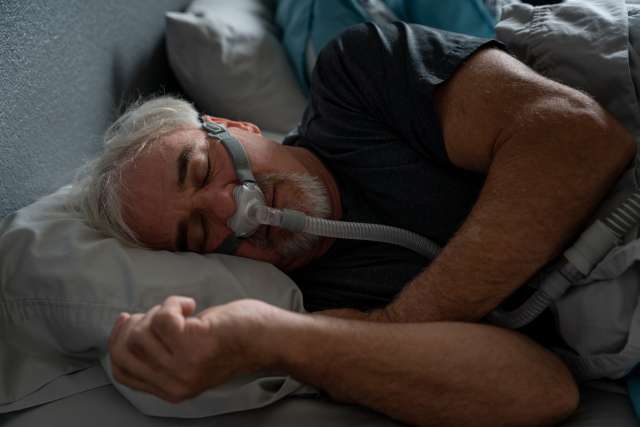Obstructive sleep apnea (OSA) is a sleep-related breathing disorder that affects 10% to 30% of adults in the United States. It could be why you snore or why you feel exhausted during the day. But OSA’s impact goes far beyond an annoyed spouse or extreme need for coffee.
OSA raises your risk for stroke, Type 2 diabetes and heart disease. But it’s also a risk factor for cognitive decline. The longer OSA goes untreated — and only 20% of people with sleep apnea know they have it — the more it can damage your brain.
Here’s what you need to know:
What is obstructive sleep apnea?
People with OSA experience pauses in their breathing while they sleep. It happens when a narrowed or collapsed airway causes a blockage that reduces airflow by 90% or more or stops it completely.
These breathing lapses don’t last long (at least 10 seconds, but sometimes up to several minutes) but happen throughout the night. Mild OSA involves episodes five times an hour; moderate to severe forms of the condition cause you to stop breathing 15 or more times an hour.
OSA causes fragmented sleep and abnormal breathing that interrupts oxygen delivery to the brain. As a result, people with OSA commonly experience:
- Daytime sleepiness
- Memory issues
- Mouth breathing, which can leave the throat dry or sore
- Neuropsychological conditions, such as anxiety, depression or inattention
- Snoring
Sleep apnea can develop at any age, but as you age, you’re more likely to experience conditions and physical changes that can lead to OSA, including: .
- Fatty tissue build-up in your neck and tongue
- Heart disease
- Weight gain
Connection between sleep apnea and cognitive impairment
The interrupted breathing that occurs with OSA interferes with getting oxygen to the brain. Without enough oxygen, the brain’s structure and function change. The decreased blood flow (ischemia) and low oxygen levels (hypoxia) that OSA causes can also damage the brain’s white matter.
White matter is a network of nerve fibers that allows different areas of the brain to communicate with each other. It makes up half the brain. If the white matter isn’t healthy or functioning as it should, your brain cells (neurons) can’t send signals properly and your cognitive function suffers.
Researchers spent four years studying cognition and white matter in people with OSA. They found that ongoing OSA changes the health of white matter and may be associated with a decline in:
- Attention
- Visual memory
- Visual processing
Preventing and treating OSA to avoid cognitive decline
Whether you have OSA or not, you can take steps to avoid fragmented breathing while you sleep.
Preventing OSA
The best way to reduce the risk of cognitive decline associated with OSA is to avoid getting it. You’re less likely to develop OSA if you make healthy lifestyle choices, such as:
- Eating a heart-healthy diet
- Limiting the amount of alcohol you drink
- Maintaining a healthy weight
- Quitting (or never starting) smoking
Obstructive sleep apnea treatment
If you are already living with OSA or have sleep apnea symptoms, treatment can improve your sleep and symptoms while decreasing your risk for cognitive issues. Research shows that treating OSA with CPAP (continuous positive airway pressure) for just 12 months can almost entirely reverse damage done to white matter. After a year of treatment, study participants notice significant improvements in their attention, memory and executive function.
A CPAP machine delivers pressurized air while you sleep to help your airways remain open, and it’s the most prescribed treatment for OSA. But there are other ways to reduce the number of nightly breathing pauses that occur:
- Avoiding alcohol: Alcohol may worsen OSA symptoms.
- Losing excess weight: Weight loss will not eliminate OSA, but it can help reduce symptoms.
- Myofunctional therapy: Engaging and strengthening the facial and mouth muscles may help prevent airway blockages.
- Oral devices: Devices that restrict tongue movement or help align your jaw help to reduce airway blockages while you sleep.
- Other positive airway pressure (PAP) treatments: Alternative PAP machines automatically adjust to your breathing, have different settings or involve a nasal device.
- Sleeping position: More than 60% of people with OSA sleep on their backs. Experts recommend side sleeping to reduce apnea episodes.
- Surgeries: Surgeons can reposition the jaw and airway tissues, use nerve stimulation to change tongue movement, or remove tonsils or adenoids that block the airways.



